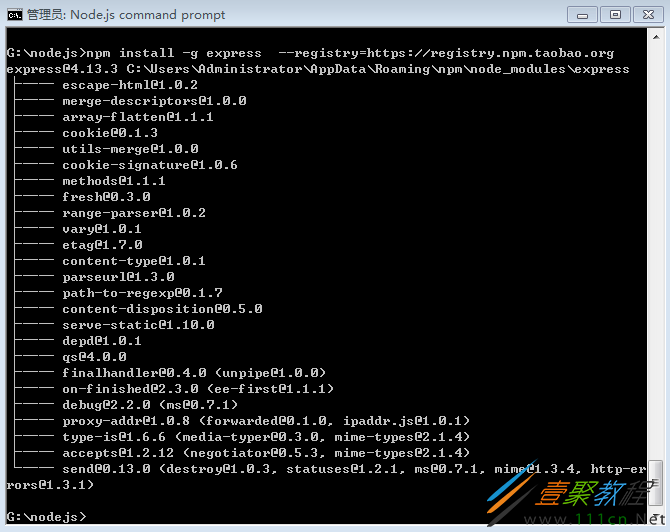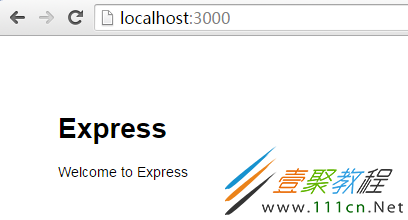Node.js Express安装与使用教程
之前我们在安装完Node.js后直接写了个HelloWorld网站,这次呢,我们使用Node.js的Web框架Express来重写一下HelloWorld,看看有什么不同。同时我们还会重写之前的文件服务器,功能更完善而代码更简洁。
安装 express
为了重写我们的HelloWorld,我们需要安装Express模块。Express基于Node.js的一个Web框架,官方网站在这里:。官网对Express的介绍是:
Fast, unopinionated, minimalist web framework for Node.js
Express很轻巧,通常用来做Web后端的开发。有一些推荐的书,可以看这里:。
要安装express模块,直接使用npm命令即可。在命令行环境下不带参数执行npm命令,即可看到npm的帮助信息。安装某个Node.js模块,使用install子命令。“npm install xxx”会将xxx模块安装到当前路径下,“npm install -g xxx”则将xxx模块安装到当前用户的全局位置。使用“npm helo install”可以查看install子命令的细节。要卸载一个模块,使用“npm uninstall xxx”,假如你是全局安装,则使用“npm uninstall -g xxx”。
在使用npm安装某个模块时,它会自动解决依赖。
在命令行环境执行下面的命令来安装express:
npm install -g express –registry=https://registry.*npm.ta*oba*o.org
注意,我指定了使用淘宝的镜像,快一些。
特别说明一下:
我参考了这里的教程哦:
很快啦,你就可以看到下面的界面(注意我们安装的Express版本是4.13.3):
好啦,Express安装完毕。
需要说明的是,使用-g命令全局安装Node.js模块后,需要设置环境变量NODE_PATH,否则在我们使用node命令启动某个应用时可能会报找不到指定的模块这种错误。在我的Windows 7环境下,全局安装时npm模块的位置为“C:UsersAdministratorAppDataRoamingnpmnode_modules”(看上面的图可知)。至于环境变量的设置,计算机->高级系统设置->高级->环境变量,添加一个名为NODE_PATH的环境变量, 将其值设置为全局模块的根目录。设置完成后,重新进入命令行环境即可生效。
提一下,如果要在NODE_PATH中添加多个模块路径,只需用“;”分隔开即可。具体含义,命令行下执行“node -h”可查看帮助。
HelloWorld
代码就是这么简单:
// 引入 express 模块
var express = require('express');
// 创建 express 实例
var app = express();
// 响应HTTP的GET方法
app.get('/', function (req, res) {
res.send('Hello World!');
});
// 监听到8000端口
app.listen(8000, function () {
console.log('Hello World is listening at port 8000');
});
保存为HelloExpress.js,然后在Node.js的命令行环境下执行“node HelloExpress.js”命令,网站就运行起来了。浏览器访问一下,和上次的示例一样一样的。
使用Express有什么不同
没有使用Express的代码是酱紫的:
// 引入http模块
var http = require("http");
// 创建server,指定处理客户端请求的函数
http.createServer(
function(request, response) {
response.writeHead(200, {"Content-Type": "text/plain"});
response.write("Hello World!");
response.end();
}
).listen(8000);
console.log("Hello World is listening at port 8000");
上面的代码直接使用Node.js带的http模块来创建HTTP服务器,指定了一个处理请求的函数。实际应用时,我们需要在这个函数内区分不同的HTTP请求,比如GET、HEAD、POST等。而Express版本的HelloWorld则有所不同,它可以针对每一个路径和HTTP请求指定响应函数,比如Express版本的HelloWorld实例,只有你在浏览器中输入“http://loca**lh*ost:8000”时它才会返回“HelloWorld”,如果你在浏览器中输入“http://localhost:8000/abc”,你就看到一条错误信息(会收到404状态码,express自动帮你处理了)。这里边有一个URL路由(URL routing)的概念。假如把代码修改成下面的样子:
app.get('*', function (req, res) {
res.send('Hello World!');
});
效果就和使用http模块的版本类似了。因为我使用了“*”作为通配符,可以匹配任何路径。Express的get方法原型如下:
app.METHOD(path, callback [, callback …])
具体可以参考这里:。
使用express创建HelloExpress
express模块有一个命令行工具express,可以用来生成基于express模块的应用结构(网站结构)。
express 4.x之后,express命令被独立出来放在了express-generator模块中。我们用下面的命令全局安装express这个命令行工具:
npm install -g express-generator
安装完成后,在命令行环境下执行“express -V”,可以看到express的版本是4.13.1。
好了,现在我们使用express命令来创建一个默认的网站。
在命令行环境下导航到myprojects这个目录下,执行下面的命令:
express HelloExpress
然后可以看到:
仔细看上面的图哦,它告诉了我们三类非常重要的信息:
- express命令创建的网站的目录结构以及创建的文件
- 安装依赖(进入到HelloExpress下,执行npm install)
- 使用npm start启动网站(express 4.x后)
好啦,我们先安装依赖。这里要先提一下HelloExpress目录下的package.json文件,其内容如下:
{
"name": "HelloExpress",
"version": "0.0.0",
"private": true,
"scripts": {
"start": "node ./bin/www"
},
"dependencies": {
"body-parser": "~1.13.2",
"cookie-parser": "~1.3.5",
"debug": "~2.2.0",
"express": "~4.13.1",
"jade": "~1.11.0",
"morgan": "~1.6.1",
"serve-favicon": "~2.3.0"
}
}
这个文件定义了一个Node.js应用的基本信息,我们这次注意的是 dependencies ,它定义了应用依赖的模块。
在HelloExpress下执行“npm install”命令,npm会自动找到package.json,分析它,安装所有依赖模块。这要花费一些时间,休息一下,去喝杯茶。
看看,下面是安装结果:
G:nodejsmyprojectsHelloExpress>npm install [email protected] node_modulesdebug └── [email protected] [email protected] node_modulescookie-parser ├── [email protected] └── [email protected] [email protected] node_modulesserve-favicon ├── [email protected] ├── [email protected] ├── [email protected] └── [email protected] [email protected] node_modulesmorgan ├── [email protected] ├── [email protected] ├── [email protected] └── [email protected] ([email protected]) [email protected] node_modulesbody-parser ├── [email protected] ├── [email protected] ├── [email protected] ├── [email protected] ([email protected]) ├── [email protected] ├── [email protected] ├── [email protected] ([email protected], [email protected]) ├── [email protected] ([email protected]) └── [email protected] ([email protected], [email protected]) [email protected] node_modulesexpress ├── [email protected] ├── [email protected] ├── [email protected] ├── [email protected] ├── [email protected] ├── [email protected] ├── [email protected] ├── [email protected] ├── [email protected] ├── [email protected] ├── [email protected] ├── [email protected] ├── [email protected] ├── [email protected] ├── [email protected] ├── [email protected] ├── [email protected] ├── [email protected] ├── [email protected] ([email protected]) ├── [email protected] ([email protected]) ├── [email protected] ([email protected], [email protected], [email protected], [email protected], http-er [email protected]) ├── [email protected] ([email protected], [email protected]) ├── [email protected] ([email protected], [email protected]) └── [email protected] ([email protected], [email protected]) [email protected] node_modulesjade ├── [email protected] ├── [email protected] ├── [email protected] ├── [email protected] ([email protected]) ├── [email protected] ([email protected]) ├── clean-css@3.3.7 ([email protected], [email protected]) ├── [email protected] ([email protected], [email protected], source-map@0. 1.34, [email protected]) ├── [email protected] ([email protected], [email protected]) ├── [email protected] ([email protected], [email protected], [email protected]) └── [email protected] ([email protected], [email protected]) G:nodejsmyprojectsHelloExpress>
有兴趣的可以研究下各个依赖模块的信息,现在我们启动网站了。执行 npm start 命令,很快就可以看到下面的图:
看到上图,说明网站已正常运行。你可以在浏览器里访问http://localhost:3000,然后就可以看到这个页面:
OK,大功告成。
这个由express generator创建的HelloExpress和我们基于express手动写的HelloWorld又有一些不同,比如你在浏览器地址栏里输入http://local*hos**t:3000/abc,就会看到一个默认的404页面,显示了具体的错误信息。而我们的HelloWorld,显示的则是“Cannot GET /abc”这个文本串。这就是模板的便利之处,有很多默认处理,可以为我们省很多麻烦。
Express版本的文件服务器
express是在Node.js的http的基础上实现的,相比http模块,封装更多更适用于web服务器场景的功能。之前我们在里使用http模块实现了一个简单的文件服务器。那个版本的文件服务器还有一个缺陷,就是没有根据文件名设置HTTP的Content-Type头部。如果我们使用express来实现文件服务器(用到了Request对象的sendFile方法),哈哈,就只有几行代码,还解决了Content-Type问题!
代码如下:
var express = require('express');
var app = express();
app.get('*', function(req, res){
res.sendFile(req.path, {root: __dirname+'/', dotfiles: 'deny'});
});
app.listen(3000);
是不是超级简单?
相关文章
精彩推荐
-
 下载
下载我的世界国际版老版
模拟经营 我的世界国际版老版我的世界国际版正式版是一款拥有超高自由度玩法是沙盒手游,经典
-
 下载
下载我的世界国际版完整版
模拟经营 我的世界国际版完整版我的世界国际服完整版是一款十分经典好玩的mc沙盒类游戏,在海
-
 下载
下载摩托车销售模拟器内置菜单中文版
模拟经营 摩托车销售模拟器内置菜单中文版摩托车出售模拟器,又名摩托车销售模拟器,这是一个以摩托车销售
-
 下载
下载船舶模拟2020最新版
模拟经营 船舶模拟2020最新版船舶模拟2020是玩法非常有意思的模拟驾驶游戏,高清3d画质
-
 下载
下载油管主播的生活2内置菜单版
模拟经营 油管主播的生活2内置菜单版油管主播的生活2内置菜单版是一款模拟养成类游戏,在这里你将体



















